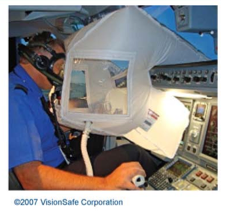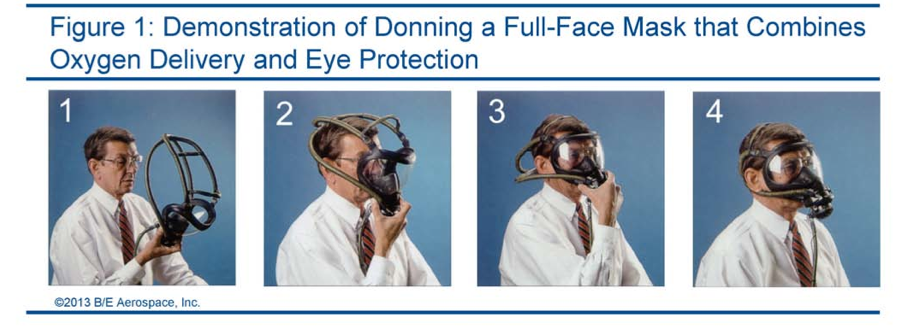UNITED STATES GOVERNMENT ACCOUNTABILITY OFFICE
 The FAA Modernization and Reform Act of 2012 directed the Comptroller General of the United States to conduct a study on the effectiveness of the Federal Aviation Administration’s (FAA) oversight of the use of new technologies to prevent or mitigate the effects of dense, continuous smoke in the cockpit of commercial aircraft. FAA oversees these procedures and technologies as part of its mission to provide the safest, most efficient aerospace system. In the initial phase of our research, we determined that there was only one technology that was developed to specifically target dense, continuous smoke in the cockpit and that this type of event occurred so infrequently that it was not practical for us to evaluate the effectiveness of FAA’s oversight. However, we were able to identify relevant procedures that are more broadly targeted—for instance, at smoke, fire, or fume events. Consistent with the mandate, we gathered stakeholders’ views regarding the effectiveness of FAA’s oversight of these procedures and the technologies related to preventing or mitigating the effects of dense, continuous smoke in the cockpit.
The FAA Modernization and Reform Act of 2012 directed the Comptroller General of the United States to conduct a study on the effectiveness of the Federal Aviation Administration’s (FAA) oversight of the use of new technologies to prevent or mitigate the effects of dense, continuous smoke in the cockpit of commercial aircraft. FAA oversees these procedures and technologies as part of its mission to provide the safest, most efficient aerospace system. In the initial phase of our research, we determined that there was only one technology that was developed to specifically target dense, continuous smoke in the cockpit and that this type of event occurred so infrequently that it was not practical for us to evaluate the effectiveness of FAA’s oversight. However, we were able to identify relevant procedures that are more broadly targeted—for instance, at smoke, fire, or fume events. Consistent with the mandate, we gathered stakeholders’ views regarding the effectiveness of FAA’s oversight of these procedures and the technologies related to preventing or mitigating the effects of dense, continuous smoke in the cockpit.
After discussing this issue with your offices, we determined that the content and focus of this GAO study—how FAA oversees the limited number of procedures and technologies that prevent or mitigate the effects of dense, continuous smoke in the cockpit and stakeholders’ views on the effectiveness of that oversight—is fully responsive to the GAO mandate contained in Section 316 of the FAA Modernization and Reform Act.
To identify how FAA oversees the use of relevant procedures and technologies, we reviewed FAA safety standards, guidance, and reports. To identify stakeholders’ views on the effectiveness of FAA’s oversight, we reviewed relevant National Transportation Safety Board (NTSB) recommendations and interviewed 15 stakeholders representing various sectors of the aviation community, including: officials from FAA and NTSB, representatives from pilots associations (Air Line Pilots Association and Coalition of Airline Pilots Associations), an air carrier trade association (Airlines for America), aircraft manufacturers (Boeing and Airbus), air carriers (United Parcel Service and JetBlue Airways), an aviation safety organization (Flight Safety Foundation), and a company that manufactures a device designed to mitigate the effects of dense, continuous smoke in the cockpit; and four aviation safety professionals. We selected these entities to represent a range of constituencies and perspectives. Safety professionals were identified based on conversations with other stakeholders. However, all stakeholders did not comment on the oversight of each identified procedure or technology. Moreover, their opinions are not generalizable to all aviation community stakeholders. To provide context for this study, we obtained the numbers of accidents and incidents from 2002 through 2012 that involved dense, continuous smoke in the cockpit identified by NTSB and FAA, respectively. We interviewed the agency officials who generated the requested analyses and reviewed official documentation that accompanied the analyses. We determined that these numbers were sufficiently reliable for the descriptive analyses used in this report. We conducted this performance audit from September 2012 through May 2013 in accordance with generally accepted government auditing standards. Those standards require that we plan and perform the audit to obtain sufficient, appropriate evidence to provide a reasonable basis for our findings and conclusions based on our audit objectives. We believe that the evidence obtained provides a reasonable basis for our findings and conclusions based on our audit objectives.
Generally, FAA oversees the safety of commercial aviation by setting safety standards and conducting a range of activities to ensure compliance with those standards. These activities include: certifying airplane design and production, inspecting air carriers’ and maintenance and repair facilities’ operations, and licensing pilots and other personnel. FAA also conducts investigations following accidents and incidents, or in response to an apparent or alleged violation, and monitors safety-related data voluntarily reported by air carriers, pilots, airplane and parts manufacturers, maintenance personnel, and others. With regard to dense, continuous smoke in the cockpit, FAA’s primary emphasis is on (1) preventing sources of ignition; (2) reducing the flammability of materials in the aircraft; (3) detecting and suppressing fires early; and (4) evacuating smoke from the cockpit. 
Read full report (PDF) here: FAA Oversight of Procedures and Technologies
www.gao.gov
“The U.S. Government Accountability Office (GAO) is an independent, nonpartisan agency that works for Congress. Often called the “congressional watchdog,” GAO investigates how the federal government spends taxpayer dollars. The head of GAO, the Comptroller General of the United States, is appointed to a 15-year term by the President from a slate of candidates Congress proposes. Gene L. Dodaro became the eighth Comptroller General of the United States and head of the U.S. Government Accountability Office (GAO) on December 22, 2010, when he was confirmed by the United States Senate. He was nominated by President Obama in September of 2010 and had been serving as Acting Comptroller General since March of 2008.” – See more at: https://www.infrastructureusa.org/nextgen-air-transportation-system/#sthash.mrCsStvw.dpuf
Tags: eye protection, FAA, face mask, GAO, oxygen delivery, Procedures, Smoke in the Cockpit, Technologies






 RSS Feed
RSS Feed